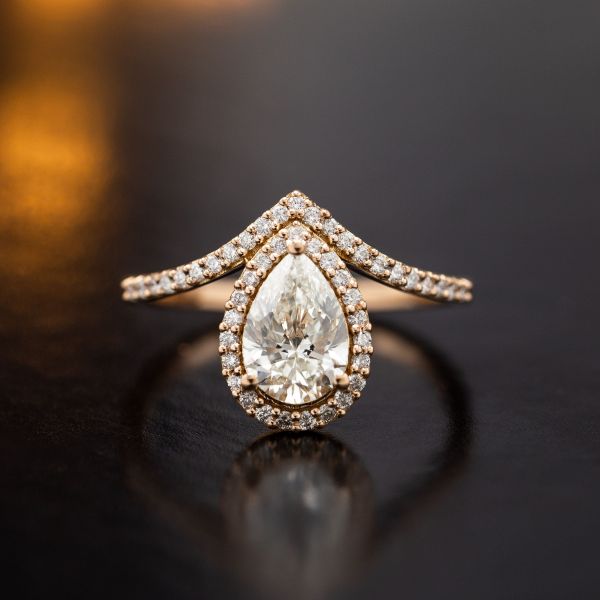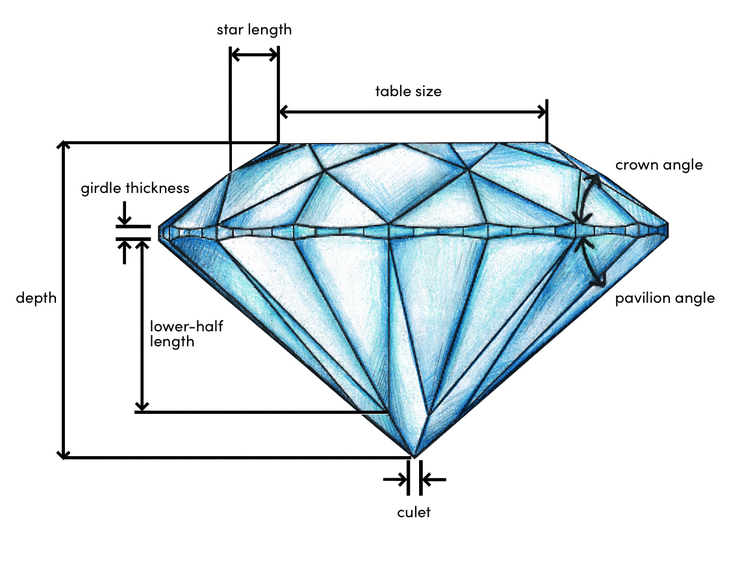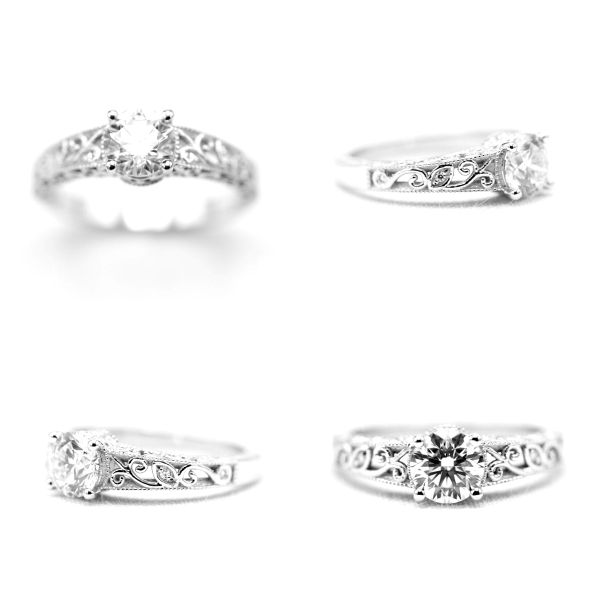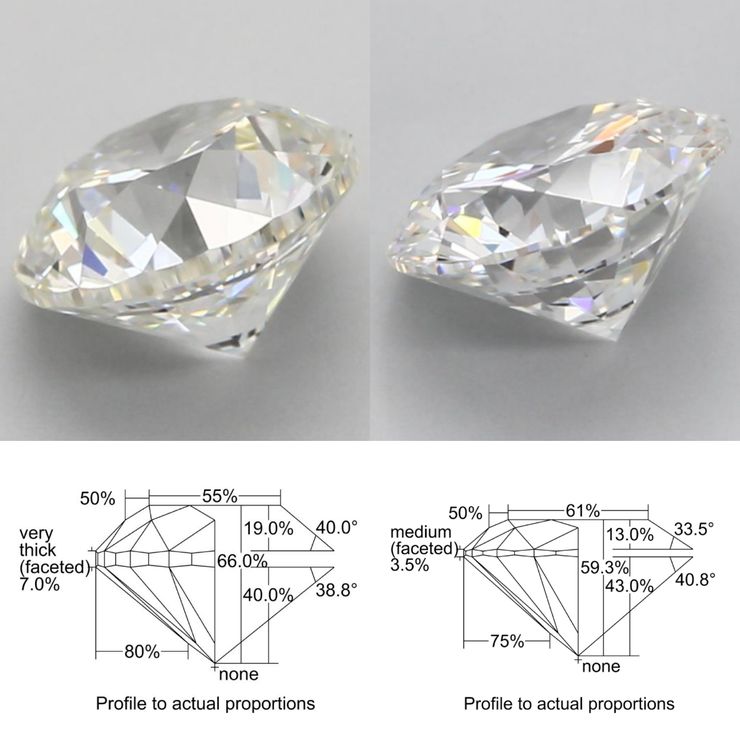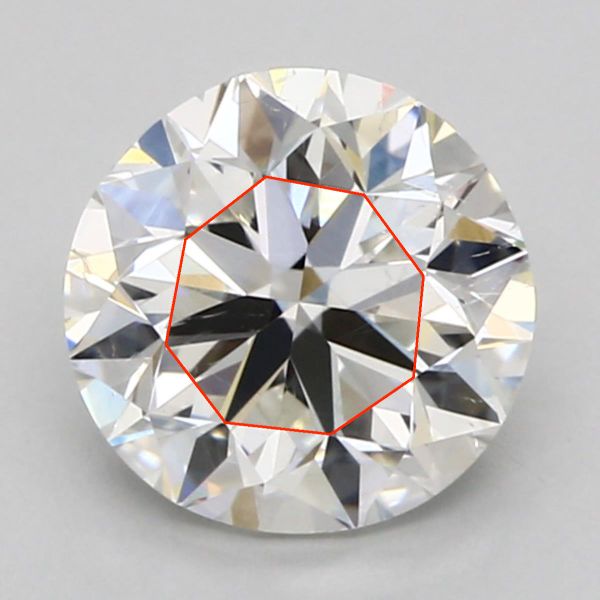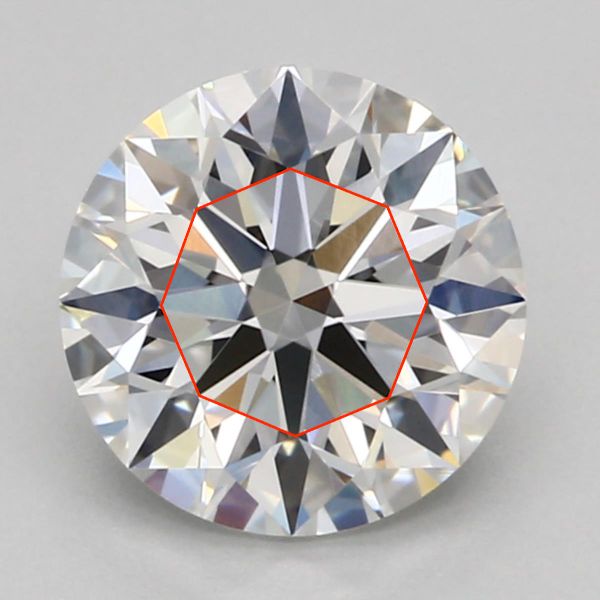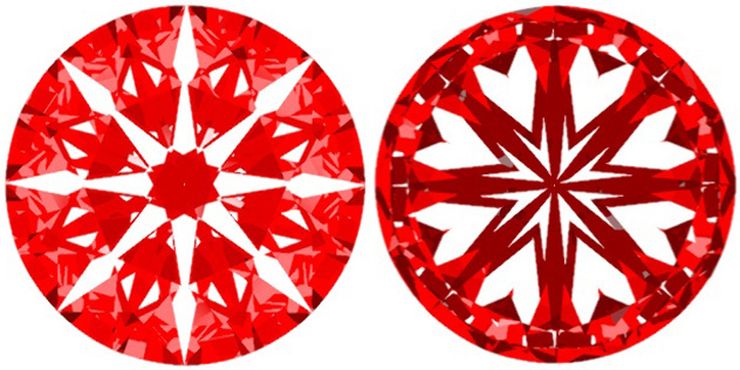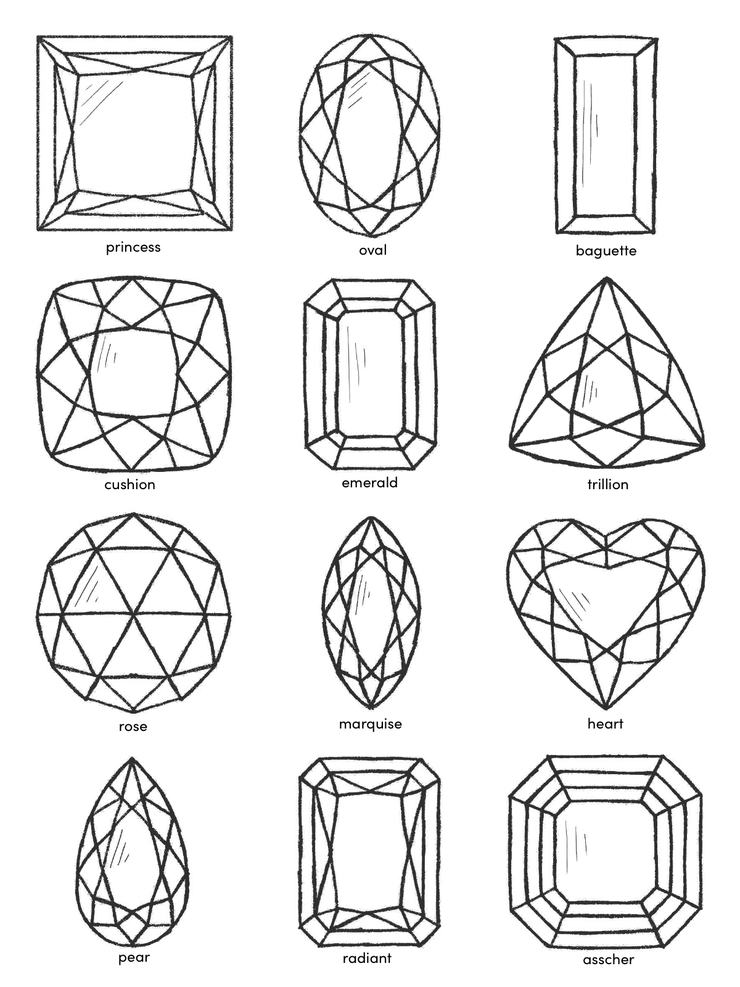Diamond Knowledge
Beyond The 4 Cs: Cut
What do you need to know about a diamond's cut grade?
This deeper dive into diamond cut grading assumes some basic familiarity with diamonds and the 4Cs. If you haven't read it yet, we'd recommend you start with our overview of the 4Cs.
What do you need to know about diamond cut grading?
We often tell our customers that cut is the most important of the 4 Cs. It's the grade that tells you how much the diamond will sparkle. For round brilliant cut diamonds, an 'Excellent' cut grade is most of what you'll need. But for other cuts, there's not even a standard grade you can rely on. And even for rounds, not all excellent cut diamonds are equal. So it can help to understand a bit more about what goes in to grading a diamond's cut.
We'll be honest: this topic gets pretty complicated. We'll do our best in this piece to explain how cut is graded and some of the important terminology around a diamond's sparkle. Even without delving into the physics of light refraction, there's quite a bit to cover. And for those interested in exploring the science of how light travels through a diamond, we'll publish a companion piece where you can geek out with us about refractive indices, leakage, and light wavelengths.
Feel free to skip around:
Our philosophy on cut
We'll start simply. Cut is critical. It produces a diamond's signature sparkle and head-turning beauty. It's not a place to compromise.
Round brilliant cut
Because of cut's importance, for round brilliant diamonds you should only consider stones with a GIA Excellent cut. GIA is highly reputable and choosing Excellent ensures you'll get a diamond that shines brightly. Of course, there are distinctions within Excellent cut. Certain proportions favor brilliance over fire or fire over brilliance. Others trade a little bit of visual spread for a little bit of brilliance. Some have exceptionally precise facet symmetry known as Hearts and Arrows. Do these nuances matter? Yes, but not a whole lot when compared with differences between cut grades. Just by picking Excellent cut, you've done 95% of the work. When it comes to that last 5%, you should trust your eye. GIA has conducted observational studies that reveal personal and regional preferences for certain diamond cuts over others. You're in the safe zone once you've selected Excellent cut and, from there, we can help you sort out more nuanced tradeoffs.
Keep in mind that GIA only grades natural mined diamonds. For lab-created diamonds, we recommend IGI's Ideal cut grade in the place of GIA's Excellent cut grade. We also review the dimensions of each lab diamond individually to ensure that the grading standard is satisfactory.
Fancy shapes (Oval, Princess, etc.)
If you're interested in a shape other than a round, things get a bit trickier because GIA only provides cut grades for round diamonds. For all other shapes, known as fancy shapes in the industry, the parameters are much more subjective. A round diamond produces the most light return, so every fancy shape compromises light performance to create the shape. For example, for an oval diamond, the best way to maximize light return would be to make it rounder and rounder until it was... round. Since fancy shapes are more about the look of the shape than maximizing brilliance and fire, GIA has decided to stay out of giving a cut grade. It's a sensible choice, but it makes things a lot harder on you as a consumer because you have to choose cut without the benefit of a third-party grading system. Most online retailers list every diamond that they have available. For fancy shapes, this means you're searching through a minefield, where the majority of diamonds you see are poorly cut. We're not fans of this thrift-shop style approach. Instead, we hand-select a curated set of well-cut diamonds for you to review. Then you can safely trust your eye and focus on your preferences, knowing that you can't go wrong with any of the options we show you.
Developing the modern cut grading system
In 1919, Marcel Tolkowsky published the first mathematically-based parameters for the faceting of a round diamond. His set of dimensions laid the foundation for the 57-facet modern round brilliant cut, which maximizes a diamond's brilliance, fire, and sparkle. Tolkowsky's findings were revolutionary in the diamond industry, paving the way for a more precise, numbers-driven approach to cutting. With modern science and technology, today's gemologists have improved on the 1919 design, taking into account more complicated light patterns that Tolkowsky didn't consider, such as light rays that bounce three or more times inside the diamond before exiting. The most notable improvements were made by the Gemological Institute of America (GIA), the world's most reputable grading laboratory, which ran an extensive scientific study before starting to publish diamond cut grades in 2006.
The GIA spent over a decade developing their cut grading system for round brilliant diamonds. They combined computer modeling of light behavior with extensive human observation of actual diamonds to develop a comprehensive rating system.
GIA's computer model analyzes 10 primary factors: 8 sets of proportions (table size, crown angle, pavilion angle, star length, lower-half length, girdle thickness, culet size, total depth), plus the role of polish and symmetry. Based on these proportions, they can model how light will behave in the diamond with regard to brilliance and fire. All 8 of the diamond's proportions, along with the cut's polish and symmetry, are critical for judging a diamond's appearance.
GIA knew that in addition to understanding maximum light return, they needed to understand which diamonds looked best to observers. A computer model alone can't determine the most pleasing balance of brilliance and fire or how viewers perceive color contrast and the associated scintillation (shimmering sparkle) of a diamond when it moves. For that task, they ran the largest observational diamond study of all time - gathering consumers, retailers, dealers, and manufacturers to make over 70,000 observations on over 2,000 diamonds. This survey data allowed them both to validate the results of their computer models and to understand the variation in personal preferences. Their results led to a few clear conclusions:
- An attractive diamond is bright, fiery, and sparkling, with a pleasing overall experience, especially when the pattern of light and dark areas is viewed face up.
- Personal preferences come into play for small tradeoffs, but larger differences in diamond proportions create clear differences in quality, which GIA breaks up into 5 cut grades ranging from Poor to Excellent.
- There is no one exactly perfect set of proportions because there are tradeoffs to be made between brilliance, fire, and scintillation. For example, some observers prefer maximum brilliance, while others prefer a bit more fire at the expense of brilliance.
Today, GIA uses the power of their light-return computer model, calibrated based on observational data to determine a diamond's cut grade based on its face-up appearance, design, and craftsmanship.
Diamond cut grading laboratories
GIA is the most broadly used and reputable grading laboratory for diamonds. They have a consistent global standard that is reliable from lab to lab. In addition to their reliability, GIA-graded diamonds have better resale value than diamonds from any other laboratory. Their reputation is outstanding for good reason, which is why they are our choice for natural mined diamonds.
We do recognize the reliability of two other grading laboratories:
- AGS (American Gem Society). AGS is less known to the general public than GIA, but within the industry also has a strong reputation. They grade on a numerical scale of 0-10 with 0 being the best and 10 being the worst for each category. They were also the first lab to issue a cut grade, starting before GIA. While they are also reputable, AGS is less broadly used and uses a completely different set of ratings from GIA. They also tend to be 0-1 grade more lenient than GIA. There are plenty of beautiful GIA-graded diamonds and learning one grading system is plenty of work on its own. That's why we stick with GIA for natural mined diamonds.
- IGI (International Gemological Institute). IGI has had major success in recent years, establishing itself as the laboratory of choice for two growing markets: lab-created diamonds globally and natural mined diamonds in China. IGI is our laboratory of choice for lab-created diamonds (which GIA doesn't grade) and we find their grading of loose diamonds to be consistent and reliable. An investigative study run by industry heavyweight Rapaport concluded that IGI's grading standard is surpassed only by GIA and by only a narrow margin. Similar to AGS, they are roughly 0-1 grade more lenient than GIA. IGI damaged their reputation in past decades by issuing inflated jewelry appraisal value reports for major jewelry chains like Kay and Zales. These reports are distinctly separate from their loose diamond grading, but we think provide an explanation for a mixed reputation in the US market, despite reliable grading.
The other most commonly seen grading laboratory is EGL (European Gemological Laboratory). EGL is widely known for issuing inflated grades for their diamonds. They use the same color and clarity scales as GIA, but issue reports several grades higher than GIA would issue. This tricks some customers into thinking that an EGL diamond is a great deal. We've never found that to be the case. GIA represents the gold standard and by far the most popular lab in the US. A diamond dealer needs to make a deliberate choice to use a different lab. If they've chosen EGL, it's probably because they're worried about getting very low ratings from GIA and are trying to game the system. EGL diamonds are graded inconsistently and have poor resale value. We recommend staying away and don't offer EGL-graded diamonds.
A note on "Ideal" cut diamonds - When talking to other jewelers or visiting other websites, you may see reference to diamonds with an 'Ideal' cut grade. IGI and AGS use Ideal as their top cut grade, but GIA, the most widely used laboratory, does not, instead issuing Excellent as their top grade. Watch out if you see GIA stones referred to as having 'Ideal' or 'Super Ideal' cut. These are not GIA grades and so should be reviewed carefully.
Diamond cut terminology
You'll see a lot of terms referenced in our discussion of a diamond's appearance, as well as in the grading on a certificate. Let's take a look at some of the important terms you'll want to know.
Brilliance
Brilliance refers to the amount of white light returned by the diamond. This is the #1 characteristic to look for in a diamond cut. A diamond returning lots of light will look bright and lively, while a poorly cut diamond will look dull and dead. The most important driver of brilliance is the relationship between the crown angle and pavilion angle. These angles play a leading role in determining how light refracts inside the diamond and, if oriented properly, back to the viewer's eye.
Fire
Fire refers to the bursts of colored light a diamond gives off as it moves. These are created because some paths of light cause the diamond to act like a prism, separating white light into its component rainbow of colors. This provides a diamond's romantic flashes of color, which can be seen even across a dimly lit room.
Scintillation
Brilliance and fire are critical, but our brains are actually most compelled by the contrast between bright and dark facets in the diamond. It's contrast that makes looking at a diamond so much more visually interesting than say, looking at a mirror or a light bulb, both of which have more brightness.
We are drawn to this look because as humans, we're hardwired to pay attention to visual contrast. For example, in the black and white photo collage below, notice how your eye is drawn to the diamond in the bottom right, where there is the most stark contrast.
That same principle is behind diamond's beauty. Diamonds can reflect incoming light from many different angles. Dark areas happen because at some angles light is blocked, for example by your head when you're looking at the diamond. The blocked light creates dark facets that contrast with the bright facets getting hit with light. Any tilt of the diamond changes which light hits which facets and thus the pattern of light and dark. This changing pattern produces flashes of light that we call sparkle. As an example, take a look at this video of one of our engagement rings, shot in subdued lighting. Notice how much your eye sees beautiful light movement in the facets, even without brilliant flashes of light. That's scintillation.
Design
A diamond cutter's goal is to maximize the value of a given piece of rough. If well-cut diamonds sell for more than poorly cut diamonds, why isn't every diamond well cut? There is always a tradeoff between the size of the diamond and the quality of the cut. A diamond's price goes up with its carat weight, particularly at major intervals like 1.0, 1.5, and 2.0. That leaves cutters balancing cut quality against carat weight. Often cutters retain carat weight that doesn't enhance or even actively hurts the look of the diamond because that extra carat weight will mean a higher price. No diamond cutter wants to make a 1.00ct diamond into a 0.99ct diamond, no matter the improvement in visual appeal. Sometimes cutters are also working around imperfections in the rough by changing the symmetry of the diamond to avoid inclusions.
The design rating takes into account how well the diamond shows its weight. Does it have nice wide spread, or does it hide weight in the girdle? It also takes into account cut issues or structural flaws, like chips, that impact the stone's long-term durability. In the image below, you can see two diamonds with the exact same weight (1.01 ct). The diamond on the left has a much thicker girdle, resulting in a deeper stone with a smaller appearance (just over 6mm across). The one on the right carries its weight much better, appearing larger (over 6.5mm across).
Polish
Traditional diamond cutting is broken into four steps: cleaving, bruting, blocking, and brillianteering. The final two steps take place on a polishing wheel where facets are added to a rough diamond by pressing the diamond against a spinning wheel containing diamond dust. The craftsmanship during these steps determines the polish grade.
GIA's polish grade refers to two things:
- How fine the polishing marks are are from the polishing wheel
- The presence or absence of other polish defects (e.g. scratches, nicks, rough girdle, etc.)
Unlike cut grade, where it's critical to score excellent, the differences in polish grades are extremely subtle.
- Excellent: There are no polish defects visible under 10x magnification
- Very good: Imperfections are very hard to see under 10x magnification
- Good: Imperfections are hard to see under 10x magnification
- Fair Polish defects can be seen under 10x magnification and may be visible to the naked eye
- Poor: Polish defects are visible to the naked eye
As you can see from this list, even a grade of Good is quite strict, containing no imperfections that will be visible to the naked eye. That means you are quite safe with a polish grade of good or above. This isn't a grading characteristic you need to understand deeply because all the diamonds you'll see fall into one of the top categories and the price differences between the top grades are small.
Symmetry
Symmetry refers to the exactness of the diamond's overall shape and the alignment of its facets. The more precise the alignment, the higher the symmetry grade. Like polish, the differences between different symmetry grades are quite subtle.
- Excellent: There are no symmetry defects visible under 10x magnification
- Very good: Symmetry imperfections are very hard to see under 10x magnification
- Good: Symmetry imperfections are hard to see under 10x magnification
- Fair: Symmetry defects can be seen under 10x magnification and may be visible to the naked eye
- Poor: Symmetry defects are visible to the naked eye
In the images below, we've traced the outline of the table facet on each diamond to draw attention to the symmetry. The one on the left has a symmetry grade of "good," and its facets are uneven, reflecting imperfect symmetry, and resulting in a much less attractive diamond. By contrast, the diamond on the right has excellent symmetry.
GIA's 70,000 person study on cut found that a rating of "Good" or lower was enough for customers to notice and begin impacting their preferences. Because of this, for a round diamond to receive GIA's Excellent cut grade, it must have either a Very Good or Excellent symmetry grade. This provides you more than enough cover, as even trained experts can struggle to distinguish visual differences in diamonds with Very Good symmetry grades from ones with Excellent symmetry grades.
For fancy shapes there are a lot more variables at play and we recommend diamonds with symmetry grades of good and above. At all of these levels we're talking about imperfections that are hard for a professional to see under 10x magnification. Symmetry grades are more focused on how the facets line up than the overall shape. They won't tell you if an oval has nice shape appeal with good curvature. That's the type of thing anyone can pick up on with the naked eye, so we find it to be much more important. Especially with fancy shapes, don't go grade-hunting. Have an expert narrow down to a set of great options, then carefully review the 360 videos. Your visual review will tell you much more about the cut than the grading report.
Hearts & Arrows
Hearts & Arrows refers to a specific type of optical symmetry present in highly symmetrical round brilliant cut diamonds. Hearts & Arrows diamonds have become very popular, and we think there's something quite romantic about them. The symmetry has a subtle effect and comes with about a 10-15% price premium.
Click here to read more about Hearts & Arrows diamonds and whether they are worth the extra cost. Our quick take: Hearts & Arrows means a more symmetrical diamond with the romantic symbolism of knowing the diamond's cut is particularly rare, and that the symbols of Cupid can be found in the diamond. That said, it makes a subtle visual difference that's very hard to see with the naked eye. Even trained graders need to use tools like an Ideal-scope to determine if a diamond meets their Hearts & Arrows standard. For some, the symbolism and rarity are worth the investment. For those looking for a perfectly cut diamond, we recommend focusing on the diamond's overall cut grade, which is far more important in determining how beautiful and brilliant the diamond will be.
Fancy shapes: more of an art than a science
Let's start by acknowledging that "fancy shape" is a pretty silly industry term. Anything other than a round brilliant cut is referred to as a fancy shape. A princess cut is fancy. An oval cut is fancy. A marquise cut is, you guessed it, fancy. OK, we're all on the same page, it's a silly term. The important thing is that there are a ton of beautiful and very popular shapes for diamonds. But while a round brilliant cut is specifically designed to optimize for light performance and maximize brilliance and sparkle, the other cuts are designed for the appeal of that particular shape.
That's not to say that round diamonds are the only choice for a brilliant, sparkly look. There are a range of other popular shapes with great light return - from oval to princess to pear shape. Other shapes, like emerald and asscher cuts, are designed to show off their geometry instead of their sparkle. So understanding how to get the best look for each shape is a bit nuanced.
Cut assessment for these fancy shape diamonds is based on many of the same principles used to evaluate rounds. The assessment is more complicated, because we've introduced an additional variable - shape. Whereas there's only one set of proportions for a perfect circle, there's no clearly optimal set of dimensions for a pear shape diamond. And since round is the ideal shape for light return, cutting a different shape requires giving up some brilliance to get the desired shape. That means that there's a lot of subjectivity in determining what is or isn't a good cut for fancy shape diamonds.
For example, many customers like extended ovals that make the wearer's fingers look slender. However, the more you extend the oval, the bigger the difference in pavilion angles between different sides of the diamond, leading to more light loss across the center of the stone. Even a well-cut oval, like the stunning diamond shown here, has a bit of light loss (sometimes called "extinction") running in a bow tie across the stone.
How light moves through a diamond
If you've read this far and you're interested in learning a bit more about light performance, keep an eye out for our next write-up on the physics of light movement through a diamond. We'll dig into the details of the way light refracts and reflects, the prism effect, refractive indices, and more. We find that sort of thing fascinating, but we won't be offended if it's way more information than you're looking for.
About CustomMade
CustomMade designs and creates one-of-a-kind, custom engagement rings and fine jewelry. Each piece we create is inspired by you, designed for you, and made just for you.

